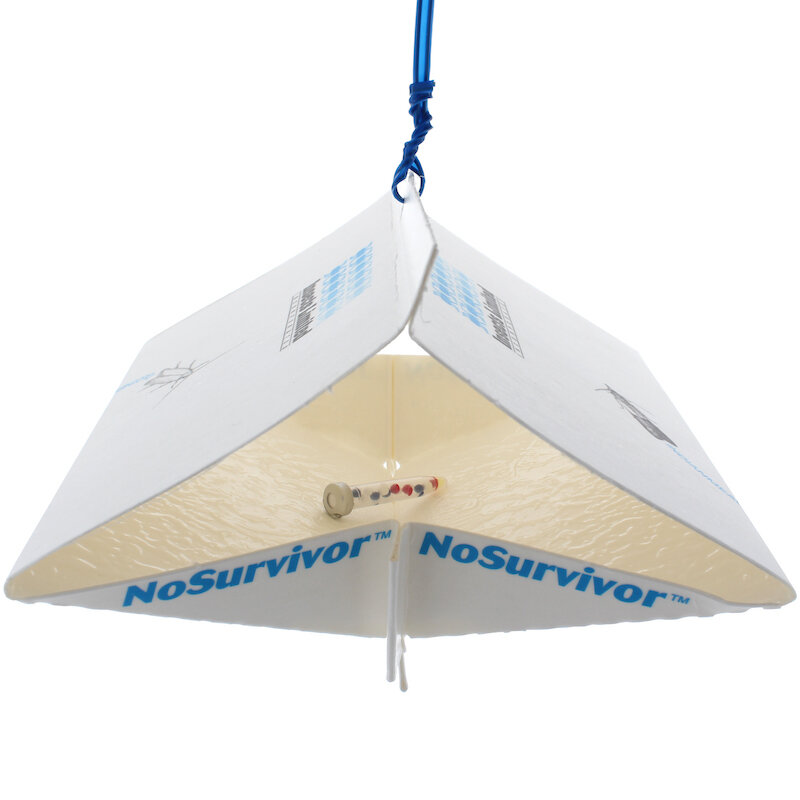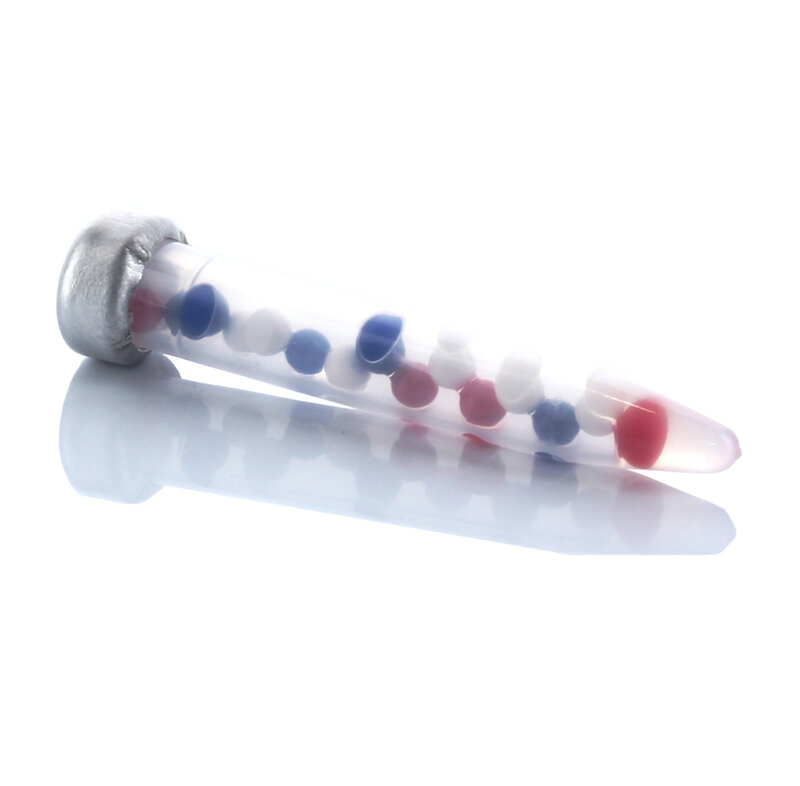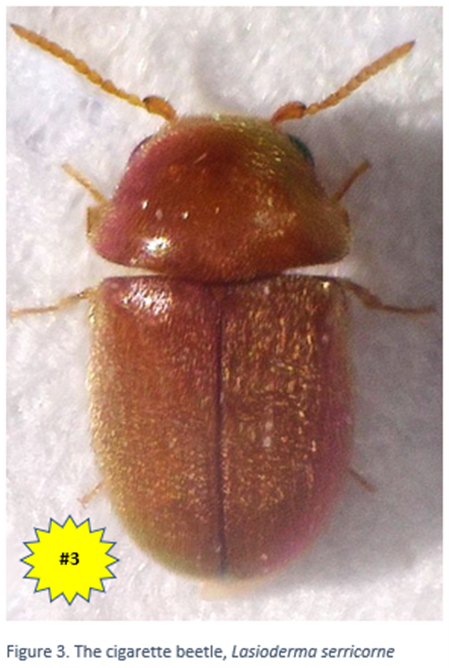The Top 5 Stored Product Insects
By Ethan Estabrook, BCE, Research Entomologist and Product Support at Insects Limited
Stored product insects are insects that can infest whole grains, processed foods, and even tobacco. These insects can usually be found in grain silos, processing facilities, storage warehouses, retail stores, and even in our own pantries.
Stored product insects cause billions of dollars’ worth of damage to the stored product industry each year.
Many can transmit molds and pathogens on their hairs and indentations on their exoskeletons to new areas. Internal feeders like weevils and the lesser grain borer can bore directly into whole grain kernels.
External feeders like flour beetles, warehouse beetles, cigarette beetles, and most food moths feed on damaged, out of condition grains, and processed foods.
This article will break down stored product insects into the top five most encountered species – the Indian meal moth, warehouse beetle, cigarette beetle, saw-toothed grain beetle, and red flour beetle.
1. Indian Meal Moth
The number one most common stored product insect encountered throughout the world is the Indian meal moth, Plodia interpunctella.
An adult Indian meal moth can be identified by a distinct two-tone pattern on the wings. The upper part of the wings contains a lighter tan / cream color while the lower part contains a darker copper / brown color. Larvae have no spots and are uniformly light cream, pink, or greenish color (depending on what type of food material they are feeding on).
Adult Indian meal moths will typically mate the first day of emergence. Females will lay 200 – 400 eggs for the next few days and live up to two weeks. A one-day delay in mating can reduce the number of eggs laid by 20%. Female moths fly from infested areas to uninfested areas to lay eggs due to an anti-egg laying pheromone chemical produced from the webbing of the larvae. The female can also detect food odors and lay her eggs near a food source in order to give her offspring the best chance of survival. Once an egg hatches, the first instar larva is small enough to invade packages through holes or gaps 100 microns wide (the same thickness as a dollar bill). Late instar larvae can chew through 25-micron cellophane, 100-micron kraft paper, and 100-micron PE plastic, though they usually start at product defects, seams, and folds. Adult moths do not have working mouthparts and all the physical damaged caused to food product are from the larvae.
The Indian meal moth can complete its life cycle in 20 – 60 days depending on temperature, humidity, and food availability. Stored product insects who have favorable conditions complete their life cycle at a quicker rate which allow populations to grow at an exponential rate causing infestations, product damage, and contamination that can then lead to recalls or negative brand image. Conversely, unfavorable conditions slow down the stored product insect life cycle which allow some of the insect life stages to live for a longer period of time but reduces the risk of infestation.
Pheromone monitoring works well with the Indian meal moth and many other stored product moth species because males are strongly attracted to the female sex pheromone.
Stored product moths actively fly in temperatures above 65 degrees Fahrenheit and can fly over 1,000 feet in 10 minutes.
The traditional “Indian meal moth pheromone” not only attracts Indian meal moths, but also attracts over 20 other stored product moth species including the Mediterranean flour moth, almond moth, tobacco moth, and raisin moth.
Pheromone Traps for Indian Meal Moth
2. The Warehouse Beetle
Stored product beetles include species like red and confused flour beetles, cigarette beetles, drugstore beetles, warehouse beetles, and weevils. The second most common stored product insect is the warehouse beetle, Trogoderma variabile. Warehouse beetles are in the family Dermestidae which include the Khapra beetle, carpet beetles, hide beetles and larder beetles.
An important characteristic in the dermestid family is their unique larvae. Larvae have spear-shaped hairs called setae in which they use as a defense mechanism, similar to porcupine quills. Larvae molt about six times and leave behind cast skins. The setae on cast skins can easily contaminate food, cause allergic reactions, and irritations if ingested. A warehouse beetle larvae caused an FDA recall of 1 million packages of baby formula in 2010. Only one package was actually confirmed infested through a customer complaint. Dermestid larvae can be very longed lived if conditions are unfavorable. Some dermestid larvae have been recorded to survive more than 5 years without food.
Warehouse beetles can be identified with their dark mottled color pattern with no scales. It can be difficult to distinguish the warehouse beetle between other insects in the same Trogoderma genus, such as the Khapra beetle. However, the Khapra beetle is unable to fly whereas the warehouse beetle can. Warehouse beetle and Khapra beetle share the same sex pheromone. A good way to distinguish between these two species is to place out hanging pheromone traps and floor pheromone traps. If insects are only caught in-floor traps and not hanging traps, then you may have Khapra beetle. The Khapra beetle is a quarantine pest and proper identification should be performed by a governing agency like the USDA.
Warehouse beetles can complete their life cycle in 30 – 60 days depending on environmental conditions. They feed on dry grain-based or high-protein foods like corn, wheat, rice, and milk powder.
Adults generally orient towards warmer dry dark locations and can survive on residual food dust inside hollow block walls, or ceiling tiles. Adults live for 1 – 2 months and females can lay 100 eggs.
Pheromone Traps for Warehouse Beetle
3. Cigarette Beetle
The third most common is the Cigarette beetle, Lasioderma serricorne. Cigarette beetles can be distinguished from drugstore beetles by the many serrated teeth antennae. Drugstore beetles have three distinct elongated antennae. Cigarette beetles can complete their life cycle in 30 - 90 days depending on environmental conditions.
They are attracted to a wide variety of products including corn, potato, spices, wheat, milk powder, seeds, dry flowers, animal skins, and tobacco. Adults are shorter-lived when compared to other stored product beetles and live for 1 – 2 months. Females can lay 100 eggs and once hatched, larvae can live on a residual layer of spillage only 1 millimeter thick.
Cigarette beetles can fly when temperatures are above 70 degrees Fahrenheit and can be monitored with hanging or floor pheromone traps. Cigarette beetles are attracted to a sex pheromone lure that is specific to the cigarette beetle.
Although drugstore beetles look very similar to cigarette beetles, they require a different pheromone lure.
Pheromone Traps for Cigarette Beetle
4. Saw-Toothed Grain Beetle
Fourth is the Saw-toothed grain beetle, Oryzaephilus surinamensis. Saw-toothed grain beetles look very similar to merchant grain beetles. Distinguishing between these two species is difficult. The temple behind the eye of the saw-toothed grain beetle is wide and about the same width of the eye, whereas the temple behind the eye of the merchant grain beetle is narrow and less than half the width of the eye.
Both species are able to fly, but merchant grain beetle do rarely. Typically, saw-toothed grain beetles feed on more dry processed rice, cereals, grains, and dried fruits whereas the merchant grain beetle prefers more oily foods like seeds and bird food. Both the saw-toothed grain beetle and merchant grain beetle have low body profiles that allow them to invade packages through defects, gaps, and vent holes.
Saw-toothed grain beetles complete their life cycle in 30 – 50 days depending on environmental conditions. Adult beetles can live up to 2 years and females can lay 200 – 400 eggs. The saw-toothed grain beetle aggregation pheromone has been identified but is very costly to produce and unstable. Food attractants can be used as an alternative to lure and monitor saw-toothed grain beetle activity.
Pheromone Traps for Saw-Toothed Grain Beetle
5. Red Flour Beetle
And rounding out at number 5 is the red flour beetle, Tribolium castaneum. Red flour beetles can be distinguished from the confused flour beetle by enlarged last three segments on the antennae where the confused flour beetle has gradually larder antennae segments. Identifying between the red and confused flour beetle is important for mainly two different reasons. First, is the red flour beetle can fly where the confused flour beetle cannot fly. This information may be important in locating flour beetle infestations and how they are managed.
The second is that the red flour beetle egg can withstand higher fumigation concentrations than the confused flour beetle. Treating for red flour beetles could cost tens of thousands of dollars more than confused flour beetles.
The flour beetle can complete its life cycle in 20 - 50 days depending on environmental conditions.
They are attracted to a wide variety of dry food ingredients such as wheat, flour, cacao, dried milk, peanuts, beans, spices, and broken grains. Adult flour beetles can live for 6 months to 2 years and female flour beetles can lay 200 – 500 eggs. 10% of a flour beetle population are adults so when you see 10 adult individuals, you can assume there are 90 other flour beetles in a different life stage as an egg, larvae, or pupae. Both larvae and adults can live on residual layer of spillage that is only 1 millimeter thick.
Larvae prefer hiding in cracks and crevices and seek heat and darkness below food surfaces.
Both male and female flour beetles are attracted to an aggregation pheromone.
Aggregation pheromone attracts both sexes to increase the probability that copulation will occur in the population. Aggregation pheromones do not work as well as sex pheromones, especially when compared to stored product moths, in monitoring programs.
Pheromone Traps for Red Flour Beetle
It is important to Start with the Insect First!
Identifying the insect and understanding their biology is the first step to an effective integrated pest management program.
Once the stored product insect has been identified, inspect areas for ideal food sources such as foods, grains, seeds, or dried plant materials.
Pheromone lures and traps are great tools to monitor and help identify the source of infestation.
Finding and treating the source can help pest management professionals solve a difficult pest problem to help protect customers’ products and brand image.
If you have any stored product insect or pheromone questions, you can contact Ethan at E.Estabrook@InsectsLimited.com.
Insects Limited, an Insect Pheromone Company
Insects Limited, Inc. researches, tests, develops, manufactures and distributes pheromones and trapping systems for insects in a global marketplace. The highly qualified staff also can assist with consultation, areas of expert witness, training presentations and grant writing.
Insects Limited, Inc. specializes in a unique niche of pest control that provides mainstream products and services to protect stored food, grain, museum collections, tobacco, timber and fiber worldwide. Please take some time to view these products and services in our web store.













